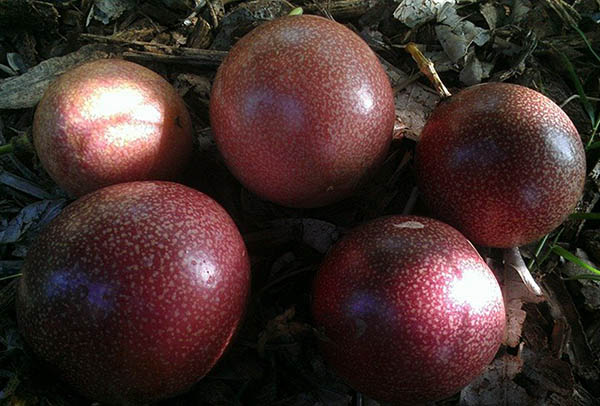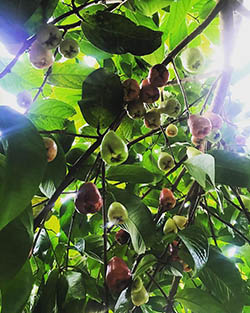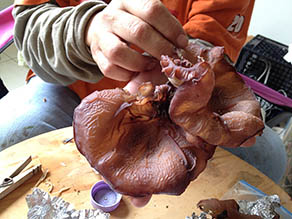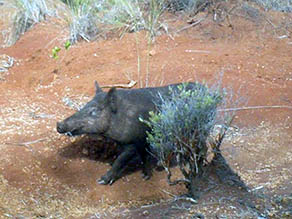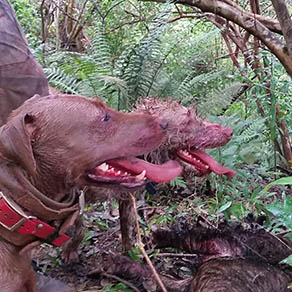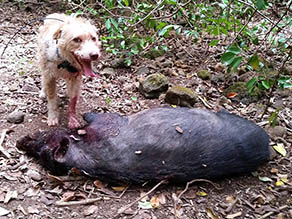 |
 |
 |
 |
||||||
|
|
|
|
|
|
|
|
|
|
 |
|
 |
|||||||
 |
“We used to hike up into the back of the valley as young kids,” Alice recalls, “with one of our cousins. I get lost over there. I’ll be lost myself. We’d hike in the mountain and we never went to any of the high heiau, we just wanted to pick up food or what the family sent us to pick. There’s a lot of medicine and stuff over there, that’s what we did, we went to pick the medicine for the older folks and the fruits. Only if you go up first you don’t touch nothing till you come back down. That is one of the big things. Nothing goes up with you. When you come back you pick whatever you want but not before. That was respect. “We gathered mountain apples, avocados, mangoes, they were the best. They were the best. A lot of that is gone because when the military went, they dug up a lot of that.” “We are definitely foragers,” Hi‘ilei says. “I was brought up that way. We never really went on hikes. If we went on a hike, it was really because we were simultaneously foraging. My dad trained us to never just walk. You’re always walking and looking for something. “During spring and early summer is ‘ōhi‘a ‘ai season, mountain apple. My tree’s done already. It’s sort of as fast as it flowered and fruited, it was done. I had two weeks of picking mountain apple and then completely done. Other trees are still going. “Other things we used to forage for in the mountains is pepeiao. They call it a wood ear fungus. It looks like an ear. Pepeiao in Hawaiian is ear. It’s good stuff. You put it in chicken and mushroom, or whatever. “We used to go and gather lilikoi, too. That’s another introduced species. But you can go in the mountains, the lower lying areas in certain places and you can find lilikoi. We used to make our own juice for family parties. There was this one spot where we could pick up garbage bags full of lilikoi and make fresh juice. Nowadays, it’s all sugar water, that nasty syrup stuff. But that’s how it was before. That patch is gone. “Hō‘i‘o is a native fern that everybody calls what we harvest hō‘i‘o, but it’s actually different. It’s different species altogether. What people are harvesting along the streams and in really wet areas is called paka. I think the Filipinos call it paka. It’s a different species but it’s a fiddlehead of a certain type of fern. We pick the young shoots and then you've got to wash it, get rid of all the hairs, blanch it, and then turn it into some sort of salad. It’s really ono. That’s another thing that I only learned to harvest probably in my college days. The native one, you've got to go in the forest, to the Hawaiian forest like Ka‘ala. Mount Ka‘ala, the top of Mount Ka‘ala in the bog, there is hō‘i‘o. Or up in Koke‘e, there is hō‘i‘o up there. Not in the back of He‘eia. It’s an introduced fern, paka. 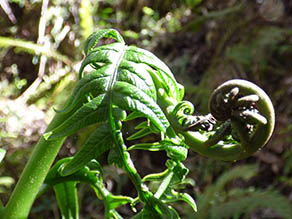
“Hō‘i‘o today is most known for people making salads out of the fern shoot,” Rick elaborates. “They call it fern shoot salad, and Hawaiians you see eat hō‘i‘o. You hear all of these stories about Kāne and Kanaloa, and their travels and when people would come across them, they would always be eating ‘opae, and they would serve them ‘opae, which is shrimp, and hō‘i‘o. So, it’s well-documented in Hawaiian history and folklore, and it was a thing that was regularly eaten. “Except today, what everybody calls hō‘i‘o is actually an introduced invasive species that is closely related to our native hō‘i‘o, but it’s not hō‘i‘o. So, same genus that Diplazium but it’s not Diplazium sandwichianum, it’s Diplazium esculentum or something like that. I don’t know. “But that whole thing, it’s like they think that they’re doing a cultural thing by incorporating this fern into their meal, but it’s not. They’re promoting an invasive species.” 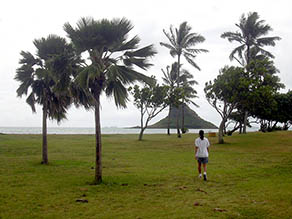
“That’s one of my pet peeves,” Hi‘ilei concurs. “I feel like we dishonor the native plant or individual by calling something that’s not native. Like, that is a Fijian fan palm. Those hanging palm fronds you see there that are all over hale? It’s not loulu. We have loulu. Loulu is on the top of our mountains. And so, I feel like some people call that loulu. But then, by calling that loulu you’re dishonoring the real loulu that’s at the top of the mountain. So I would rather just perpetuate that that is Fijian fan palm. It’s used in landscaping. “It all comes down to storytelling. That’s the same with the kalo. So many Hawaiian varieties of kalo, and all of this kalo that’s being planted and passed around. So much of the kalo that’s given to us is given to us as a certain name, and then we perpetuate that as being that particular type of kalo when in actuality it’s not. It’s just like we’re telling the wrong story.” Keola Dalire talks about gathering plants for hula Hunting: “I grew up hunting, not on this island,” Hi‘ilei says. “I would go with my dad to visit family on the outer island or to Moloka‘i. So I know a bit about hunting. In this area, most of the people hunt with dog and knife. There’s different type of pigs that were introduced. There’s a Polynesian pig that came with our people on the canoe. But for the most part, those have been bred out. What you’ll find is what we call wild pig, wild boar. It might be a little bit Polynesian pig, but you get the European mix and so on. Most of them are black, but they’re introduced. “They wreak havoc on our native ecosystems up in the forest. They’re undesirable because of what they do. They do a lot of damage to our native forests. They’re here near the fishpond, and down in the low lands. I get pigs across my stream all the time. I see them, call my cousin to come over with his bow. "But down in the lowlands, with our restoration efforts going in He‘eia, with Papahana Kuaola, sometimes you’ll hear them talk about a pig came down and they demolished the entire patch of huli, taro that was just planted. Another time, there was pigs that came in and they ripped out all of the uahi a Pele variety. The one patch that had uahi a Pele, that’s what they ripped out. And then Kako‘o ‘Ōiwi across the street. “I’ve seen pigs around,” Nick Reppun admits. “There’s signs of them even sometimes they come down here and they poke through the mulch. Sometimes they bother the taro, sometimes they don’t, but there’s a lot of people that hunt in this area—actually, they come from the other side of the ridge or off of Kahekili Highway. A lot of them are He‘eia folks, a lot of them are Windward-side people, Ko‘olaupoko folks. “There’s people that have been hunting in this area. Since I think in the 90s, there were people running cattle through here, but other than that, there hasn’t been much activity here for a long time. And so, it’s just bushes, forest, whatever people go into those areas to hunt. I see a lot of people that have been hunting here for a long time too. “I like to raise my animals. I don’t have to go chase them through the bushes to get them onto my plate, you know?” “There’s just tons of feral pigs everywhere in this whole island,” Hi‘ilei continues. “Most of the land here in O‘ahu is privately owned. So there’s not a lot of public hunting area. The public hunting area is in the Wai‘anae Mountains. But if you’re from this side, you’re going to come this side, you’re from Kahalu‘u, you’re not going to drive all the way to Wai‘anae to go hunting. We do a lot of hunting and it ends up being trespassing. “There’s that ecosystem service that you’re doing and that you’re turning a problem into a benefit. You’re feeding your family. You can make sausage, you can make smoked meat. And then there’s the private-landowner side of it where they see it as a liability. ‘Somebody’s trespassing on my land, it’s a liability.’ “The typical method that I grew up with is hunt dog and knife. You go out with a pack of dogs, they’re all trained. They’re in the dark, typically, or late evening to the dark, or early morning. Let the dogs go, you’re in the bushes. You hear the dog bark, you go running after the dogs, and the dogs collectively have a pig pinned down. They physically back it into a corner and they bite. The dogs are trained. Sometimes you have a grabber, and they grab the jugular. They’ll be pulling at the pig every which way. The pig’s typically cornered, has no options. The hunter will come in and either shoot it in the head, down it if you can find a head shot or just bleed it with a knife. So that’s dog and knife, some animal lovers don’t like that style of hunting, but that’s a tradition. "Dogs die, dogs get cut. Some people, they bring their stitching kit with them in the mountains, definitely. I have not encountered that. I would cry, probably. The other way is you just go out with a gun, but O‘ahu, kind of hard to shoot a gun on O‘ahu when you’re completely surrounded by people, right? There’s homes everywhere. So now, a lot of folks are actually doing bow hunting. My cousin, who was dog and knife for his whole life, he got introduced to bow hunting.Regular bow. He just bought a crossbow the other day. But regular bow. When I come home from work, I clean up my yard. I hear the pigs from the other side of the stream and call my cousin. He’ll come down and take care of them. It’s kind of a big thing. Maybe not such a big thing on this side of the island. 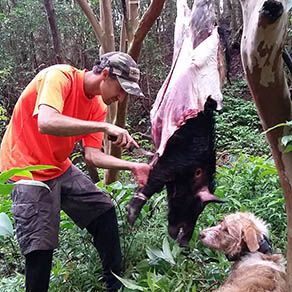
“There’s certain families that do continue to pig hunt. In the outer island, it’s huge. I feel like everybody in the outer islands is a hunter. On O‘ahu, all we have is pig and then some game birds. On outer islands, they have other things like pigs, and goats, and deer, and mouflon sheep. All of things have been introduced for this game-hunting industry, but all of these animals are very detrimental to our native ecosystem. It’s a practice that should be encouraged as a means to protect our habitat. "Typically wild pigs, the skin is removed because the hair is so thick. It’s like armor. Especially the boars, it’s hard. So they’ll skin it—skin off, hair off—and it’ll just be the meat, deboned. Either you’re going to smoke meat or you’re going to make sausage, pretty much. Smoked meat, everybody has their different recipes, but typically garlic is involved. Sometimes sugar, sometimes Hawaiian chili pepper, and then you just hang the meat in the smoker and then chop that up in the morning with some onions. It’s a good breakfast. Any party you go to on any island, what we call a pupu line, the pre-party hors d’oeuvres at a Hawaiian party will always involve smoked meat.”
|
 |
|
 |
The food provided by the land. is just one part of the traditional sustenance. One the next page, we will hear about gathering on the reef.
|
 |
||
 |
|
 |
||

|
 |
||||
|
||||
Copyright 2019 Pacific Worlds & Associates • Usage Policy • Webmaster |
||||
